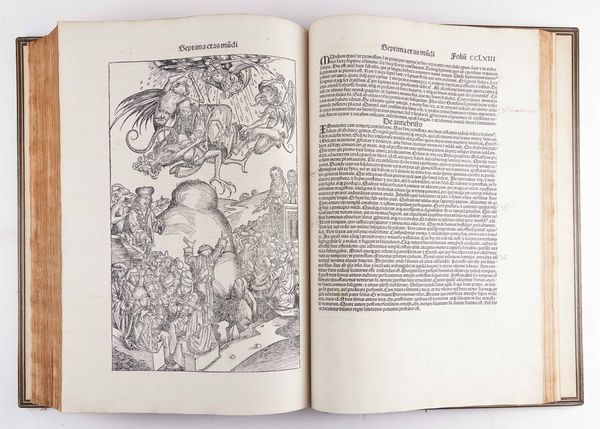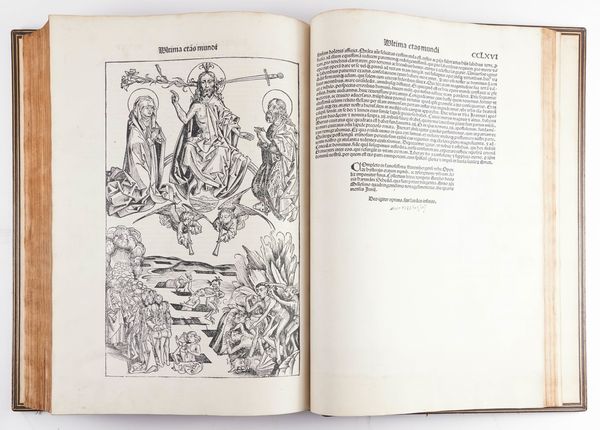"NUREMBERG CHRONICLE" - Hartmann SCHEDEL (1440-1514). Liber chronicarum, Nuremberg, 1493, large folio, woodcut illustrations, 19th-century morocco. FIRST EDITION OF THE MOST LAVISHLY ILLUSTRATED OF ALL INCUNABLES.
| Estimate: | £20,000 - £30,000 |
| Hammer price: | £50,000 |
"NUREMBERG CHRONICLE" - Hartmann SCHEDEL (1440-1514). Liber chronicarum. [Calligraphic woodcut title on first leaf:] Registrum huius operis libri cronicarum cum figuris et ymagibus ab inicio mundi. [From the final colophon:] Nuremberg: Anton Koberger for Sebald Schreyer and Sebastian Kammermeister, 12 July, 1493. Large folio (459 x 315mm). 19 "registrum" or index leaves at the front, Latin text, partly printed in double column, c.62-66 lines to a page, the first text leaf with a large initial faintly hand-painted in red and blue, folios I - CCLXVI (CCLXVI with colophon [the first of two] on the recto dated 1 June, 1493, and verso blank), followed by 5 unnumbered text leaves, the first of which headed "De Sarmacia regione Europe", then a blank leaf [?possibly later], and concluding with the remaining folios CCLXVII-[CCC]; with folios CCLVIIII - CCLXI left blank, as usual, apart from the printed running-titles [these leaves sometimes lacking, but present here, although 2 appear to have been re-margined (CCLVIIII and CCLXI)], the whole comprising a total of 326 leaves, with all numbered folio leaves present, and one internal unnumbered blank, c.1,800 woodcut portraits and illustrations throughout, including some full-page, town views, including 29 double-page, by Michael Wolgemut, Wilhelm Pleydenwurff and Albrecht Dürer, and including a double-page map of the world [Shirley 19, see note] with figures of "monsters" in the side border and on verso, and a map of Europe by Hieronymous Münzer after Nicolas Khrypffs (the first printed "Registrum ..." leaf preceded by 2 later blank leaves or endpapers, spotting to calligraphic title, some faint, mainly marginal, spotting and staining, with a few darker spots, a few leaves torn at margins, not affecting text or illustration, a few inconspicuous repairs, some inconspicuous scattered worming starting with a single wormhole at CCXLIX but becoming more widespread towards the end, although the wormholes are discernible only when the individual leaves are held up against the light; the final colophon leaf, with colophon on recto, being the last printed leaf, followed by two later blank leaves, or endpapers; the whole possibly, but - if so - inconspicuously, washed at some point). FINELY BOUND in 19th-century panelled dark olive brown crushed morocco by FRANCIS BEDFORD, the covers with a large central gilt-stamped strapwork cartouche, gilt cornerpieces and ruled in gilt and blind, the spine with 6 raised bands, 2 compartments lettered in gilt, the others with gilt foliate decoration, endpapers probably later, gilt edges (some minor scuffing, upper edges of raised bands lightly rubbed). Provenance: The Property of a Lady, by descent from her great grandfather; some contemporary or old marginal annotation, with occasional manicules, one of which part of a fuller portrait [?possibly of the reader, illustrated] (see folio CCLXXXVIII, verso). FIRST EDITION OF THE MOST LAVISHLY ILLUSTRATED OF ALL INCUNABLES, and one of the first printed books to successfully integrate text and illustration. "The Nuremberg Chronicle", as the work has popularly become known, is a complete history of the Christian world. It divides this history into seven ages, from the Creation to the Last Judgement, citing classical and Medieval sources including Pomponius Mela, Pliny the Elder, Gaius Julius Solinus, the Venerable Bede and Vincent of Beauvais. The double-page woodcuts of towns and cities, with the single exception of that of Lübeck, are the first printed views in existence, often with features and topography recognisable to this day, while some of the smaller views are more generic in nature. Similarly, a large proportion of the portraits can make no claim to verisimilitude since the same woodblocks were frequently used to depict different bishops, saints or martyrs. The double-page world map by Michael Wolgemut (Durer's master) and Wilhelm Pleydenwurff, however, is of particular interest, not just cartographically, but for its array of depictions of bizarre humanoid creatures which were then thought to inhabit the remoter regions of the world. (For a detailed identification and fascinating account of these, see Edward Brooke-Hitching's The Phantom Atlas (London, 2016, pp.174-181)). An edition of the Chronicle in German, also printed in Nuremberg, was published five months after this first Latin edition, with a third printing following in Augsburg in 1497 which is, according to Brunet, "... fort inférieure à la précédent, tant pour l'impression du texte que pour les gravures ...". The present copy, in addition to lot 216, is in a fine binding by the renowned bookbinder Francis Bedford (1799-1883) whose collection "comprising magnificent examples of his world-known bibliopegistic skill" (to quote the catalogue) was sold at auction over five days in March 1884 by Sotheby, Wilkinson and Hodge. The British Library contains many examples of his work. Alden and Landis European Americana 1493-1776 21; BMC II, 437; Brooke-Hitching The Phantom Atlas (London, 2016) pp.174-181; Brunet I (under "Chronicarum"): "Ce livre, connu sous le nom de Chronique de Nuremberg ... est très remarquable à cause des gravures en bois assez belles dont il est orné, et qui sont au nombre de plus de 2000"; CIBN S-161; Goff S-307; Hain 14508*; Klebs 889.1; Oates 1026; Polain (B) 3469; Proctor 2084; Schäfer Fünf Jahrhunderte Buchillustration (Nuremberg, 1987) p.45-46; Schreiber 5203; Shirley The Mapping of the World. Early Printed World Maps 1472-1700 (1983) 19; Steinberg Five Hundred Years of Printing (1974) p.58: "Schedel's Liber chronicarum (1493) was perhaps the most sumptuous of Koberger's publications; it contained some 1,800 woodcuts ... which make the book a mine of iconographic, geographic, and cartographic information"; Alan G. Thomas Great Books and Book Collectors (1975) pp.53-55.

































